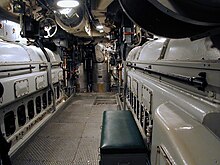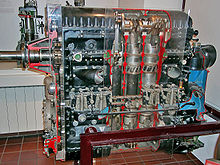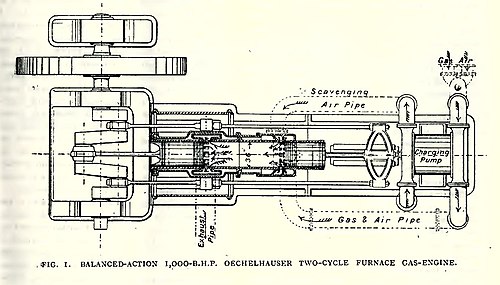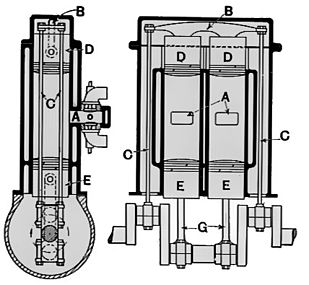Opposed-piston engine

An opposed-piston engine is a reciprocating internal combustion engine in which each cylinder has a piston at both ends, and no cylinder head.
Early first opposed piston engines

In 1882 James Atkinson developed the Atkinson cycle, a variant of the four stroke Otto cycle. The first implementation of this was arranged as an opposed piston engine, the Atkinson differential engine.[1]
Opposed piston engines using the two stroke cycle are known to have been made by Oechelhäuser as early as 1898,[2] when a 600 hp 2-stroke gas engine was installed at the Hoerde ironworks. These engines were made by Deutsche Kraftgas Gesellschaft from 1899, and by other companies under licence including William Beardmore & Sons Ltd in the UK.[3]
Smaller versions of opposed piston engines suitable for motor vehicles probably begin with the French company Gobron-Brillié around 1900. In April 1904 a Gobron-Brillié car driven by Louis Rigolly and powered by the opposed piston engine was the first car ever to exceed 150km/h with a "World's Record Speed" of 152.5km/h[4] and on 17 July, again driven by Rigolly, the first to exceed 100 mph for the flying kilometre.[5]
The first diesel engine with opposed pistons, was a prototype built at the Kolomna plant in Russia. The designer Raymond A. Koreyvo on November 6, 1907 patented the engine in France, then displayed the engine at international exhibitions. After these demonstrations similar engines were produced by other companies. Koreyvo filed a claim against these companies which was rejected by the Kolomna plant as the managing director did not want any quarrels with influential foreigners. In the USSR, the opposed piston engine was used only after meetings with German aircraft makers, Junkers, relating to the Jumo 205 opposed piston diesel engine. In the USSR locomotive diesel engines adapted American Fairbanks-Morse designs. These engines were also used in military boats, set out under the world war two Lend-Lease contracts.[citation needed]
-
Oechelhäuser Gas Engine
-
Beardmore version of Oechelhäuser Engine
-
Gobron-Brillié opposed-piston engine, with overhung yoke, from 1900
Configurations
Opposed piston engines should not be confused with flat engines, which are horizontally opposed with one piston per cylinder, and cylinder heads.
Some variations of the opposed piston or OP designs use a single crankshaft. The Gobron-Brillié,[5] and Doxford ship engines[6] used a crankshaft at one end of the cylinders and a crosshead for the opposing piston. The crank throws for each end were often unequal giving a shorter motion for the end having the higher reciprocating weight in order to help balance.

The Commer TS3 3-cylinder truck engines (originally designed by Tilling-Stevens) have a single crankshaft beneath the centre of the cylinders with both pistons connected by levers.[7] This type of engine configuration dates at least back as far as 1914, as a 2-stroke petrol engine referred to as the "Simpson's balanced two-stroke" was described in the Motor Cycle magazine of this date.[8] This design used crankcase compression, and used one piston to uncover the transfer port, and another to open the exhaust port allowing the fresh charge to flow from one end of the cylinder to the other, thereby avoiding the need for deflector crowns for pistons used in most 2-strokes at that time. The levers operating the pistons allowed for a large piston travel with smaller crank throw.
A more common layout uses two crankshafts, with the crankshafts geared together, or even three geared crankshafts in the Napier Deltic diesel engines. The Deltic uses three crankshafts, one at each corner, to form the three banks of double-ended cylinders arranged in an equilateral triangle. These were used in railway locomotives (British built Class 55 and Class 23) and to power fast patrol boats. Both types are now largely obsolete, although the Royal Navy still maintains some Deltic-powered Hunt-class mine countermeasure vessels.
The first opposed-piston diesel engines were developed in the beginning of the 20th century. In 1907, Russian Raymond Koreyvo, the engineer of Kolomna Works, built an opposed-piston two-stroke diesel with two crankshafts connected by gearing. Although Koreyvo patented his engine in France in November 1907, the management would not go on to manufacture opposed-piston engines.

The first Junkers engines had one crankshaft, the upper pistons having long connecting rods outside the cylinder. These engines were the forerunner of the Doxford marine engine, and this layout was also used for two- and three-cylinder car engines from around 1900-1922 by Gobron-Brillié.[9] There is currently a resurgence of this design in a boxer configuration as a small aircraft Diesel engine, and for other applications, called the "OPOC"[10] engine by Advanced Propulsion Technologies, Inc. of California.[11] Later engines, such as the Junkers Jumo 205 diesel aircraft engine and today's Achates Power engine, use two crankshafts, one at either end of a single bank of cylinders. There are efforts to reintroduce the opposed-piston diesel aircraft engine with twin geared crankshafts for general aviation applications, by both Dair and PowerPlant Developments in the UK.[12]
This configuration has also been used for marine auxiliary generators and for larger marine propulsion engines, notably Fairbanks-Morse 38 8-1/8 diesel engines used in both conventional and U.S. nuclear submarines. Fairbanks-Morse also used it in diesel locomotives starting in 1944. With the addition of a supercharger or turbocharger, opposed-piston designs can make efficient two-stroke cycle Diesel engines. Attempts were made to build non-diesel 4-stroke engines, but as there is no cylinder head, the bad location of the valves and the spark plug makes them inefficient.
Koreyvo, Jumo and Napier Deltic engines used one piston per cylinder to expose an intake port, and the other to expose an exhaust port. Each piston is referred to as either an intake piston or an exhaust piston depending on its function in this regard. This layout gives superior scavenging, as gas flow through the cylinder is axial rather than radial, and simplifies design of the piston crowns. In the Jumo 205 and its variants, the upper crankshaft serves the exhaust pistons, and the lower crankshaft the intake pistons. In designs using multiple cylinder banks, such as the Junkers Jumo 223 and the Deltic, each big end bearing serves one inlet and one exhaust piston, using a forked connecting rod for the exhaust piston.
The Doxford Engine Works of the UK designed and built very large opposed-piston engines for marine use. These engines differ in design from Jumo and Fairbanks-Morse engines by having external connecting rods linking the upper and lower pistons, thus requiring a single crankshaft. The first engine of this type was developed by Karl Otto Keller in 1912. Doxford obtained a sole UK license from Oechelhauser and Junkers to build this design of engine. After World War I, these engines were produced in a number of models, such as the P and J series, with outputs as high as 20,000 horsepower (15,000 kW). Certain models were license-built in the US. Production of Doxford engines in the UK ceased in 1980.[6][13][14]
Assembly and function

1. Intake for fuel-air mixture
2. Supercharger (here: rotary vane pump; original: Centrix)
3. Airbox to buffer and distribute the mixture
4. Waste valve to limit the pressure level
5. Outlet crank mechanism (runs app. 20° before inlet to achieve an asymmetric control diagram)
6. Inlet crank mechanism
7. Cylinder with inlet and outlet slots
8. Exhaust
9. Water cooling jacket
10. Sparkplug
Other views: animation (587 kB), or perspective.
Shown at right is the layout of a two-stroke engine similar to the one developed by engineer Kurt Bang at the Prüssing Office on the basis of the pre-war DKW race engine. There were two versions: one with a displacement of 250 cm3 (15 cu in), and one with 350 cm3 (21 cu in) displacement. The engine had two cylinders with four pistons, two crankshafts and a supercharger. The crankshafts were connected by gears.
The supercharger takes in the fuel-air mixture, compressing it and pushing it into the airbox. From here it reaches the crank housings. On the outlet side it cools the thermically high loaded piston. After ignition the pistons move outwards, performing the power stroke. At first, the outlet piston opens its slots in the cylinder. The remaining pressure accelerates the gas column towards the exhaust. Then the other piston opens the inlet slots. The pressurized fresh mixture pushes the remaining waste gas out. While the inlet is still opened, the outlet is closed. The supercharger forces additional gas into the cylinder until the inlet slots are closed by the piston. Then the compression stroke starts and the cycle repeats.
Production ceased in 1998, but the U.S. and British militaries still purchase re-manufactured engines on occasion.[citation needed]
Free-piston engine
A variation on the opposed-piston engine is the free-piston engine, which was patented in 1934 by Raúl Pateras de Pescara. It has no crankshaft, and the pistons are returned after each firing stroke by compression and expansion of air in a separate cylinder. Early applications were for use as an air compressor or as a gas generator for a gas turbine, such as the Pratt & Whitney PT1 design. There is now renewed interest in it for powering vehicles by using it to drive a linear alternator.
See also
- Michel engine
- Fairbanks Morse 38 8-1/8 diesel engine
- Junkers Jumo 205
- Commer TS3 "The Commer Knocker" commercial vehicle engine
- Leyland L60 tank engine, used in the Chieftain tank; similar in layout to the Junkers Jumo 205 and Napier Culverin
- Rolls-Royce K60 engine, smaller and improved version of the L60 used in the FV430 series armoured fighting vehicles and Swedish tank Strv 103
- Napier Deltic
- Soviet engine 5TDF used on tank T-64
- Soviet engine 6TD used on tanks T-80UD, T-84 and Al-Khalid
- Achates Power
- British Rail Class 55
- British Rail Class 23
References
- ^ Gingery, Vincent. Building the Atkinson Differential Engine. David J. Gingery Publishing, LLC. ISBN 1878087231.
- ^ "Large Gas Engines on the Continent", Page's Weekly, 23 June 1905, pp1336-7
- ^ "The Oechelhauser Gas Engine in Great Britain", Paper Read Before the Glasgow University Engineering Society, 11 November 1909. Published by William Beardmore & Sons Ltd
- ^ The Automotor Journal, 9 April 1904, p421
- ^ a b "Heritage/Lost Marques/Gobron-Brillie". www.uniquecarsandparts.com.au. Archived from the original on 25 August 2013.
- ^ a b "Marine Engines – Doxford - Page 1". OldEngine.org. Archived from the original on 2 December 2013.
- ^ "Rootes-Lister – TS3 Horizontally Opposed Piston Engine Page 1". OldEngine.org. Archived from the original on 25 February 2008.
- ^ "A Horizontally Opposed Two-stroke Engine", The Motor Cycle, 6 August 1914, p204
- ^ L.J.K. Setright. Some Unusual Engines. ISBN 0-85298-208-9.
- ^ "The Patented opoc Engine".
- ^ Peter Hofbauer. "Stroke of genius – OPOC takes two". Engine Technology International. Archived from the original on 20 December 2005.
{{cite web}}: Unknown parameter|deadurl=ignored (|url-status=suggested) (help) - ^ "The 100hp Liquid Cooled Diesel Aircraft Engine". Diesel Air Limited. Archived from the original on 4 April 2006.
{{cite web}}: Unknown parameter|deadurl=ignored (|url-status=suggested) (help) - ^ "Doxford Engines 1878–1980". Doxford Engine Friends Association.
- ^ "Junkers Ship Engines". Horst Zoeller. Archived from the original on 25 October 2009.
External links
- Opposed Piston Engines Website
- History of the Pescara Opposed-Free-Piston Engine
- Fairbanks-Morse 38D8 Diesel Engine
- Achates Power Engine
- "Opposed Piston Opposed Cylinder Engine" video at Engineering TV
- "Toroidal Free Opposed Piston Engine" from Franky Devaere
- http://www.sixstroke.com/
- OPRE engine
- PatOP engine
- Start-Ups Work to Reinvent the Combustion Engine
- Pinnacle Engines
- [1]



